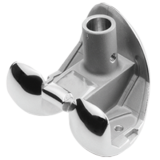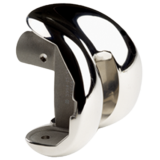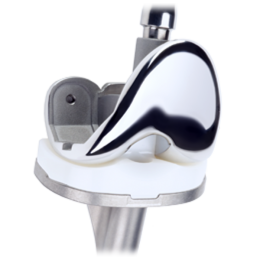Product Description
The NexGen LCCK is intended for patients who, in the surgeon’s judgment, require additional prosthetic stabilization due to inadequate mediolateral, anteroposterior, and varus/valgus ligament function, and require augmentation and/or stem extensions due to inadequate bone stock. For use when both cruciate ligaments are excised and when greater varus/valgus constraint is required (an LCCK Femoral Component can be used with NexGen LPS Articular Surface, however, less varus/valgus constraint is provided). The NexGen LCCK can be used with augments and stem extensions.
Prosthetic Constraint
For patients who lack functional collateral ligaments or whose knees cannot be stabilized by the usual tissue releases, the LCCK features an elevated tibial spine and deeper femoral intercondylar box. A close fit between the spine and box provides stability as the mechanical rollback is induced, inhibiting posterior subluxation and limiting varus/valgus movement to +1.25 degrees and internal/external rotation to +2 degrees. This design accommodates a theoretical range of motion in excess of 120 degrees.
Modular Femoral Tibial Augments
For patients with inadequate bone stock, tibial and femoral augments offer true patient specificity. Tibial: third-, half-, and full-wedge augments or 5-20mm blocks in 5mm increments in Titanium or up to 30mm in Trabecular Metal Material. Femoral: posterior, distal, posterior/distal, and anterior augments. Augments are designed for either screw or cement fixation (anterior augments are cement fixation only), and come available in either Titanium or Trabecular Metal Material.
Stems
The Zimmer NexGen LCCK System offers a reported survivorship of 96% at 10+ years when used for revision TKA.1
Interchangeable between all stemmable NexGen Femoral and Tibial Components, straight and offset stem extensions allow the surgeon to optimize canal fill and component positioning.
For patients whose canal is not centered relative to the distal femur or proximal tibial surface, the patented offset design allows the component to be positioned 4.5mm away from the center of the canal in any direction. This flexibility provides for a full 360 degrees of orientation for improved bone coverage, and allows the surgeon to optimize implant position.
Please refer to the package inserts for complete product information, including contraindications, warnings, precautions, and adverse effects.
References
- Kim YH, Kim JS. Revision total knee arthroplasty with use of a constrained condylar knee prosthesis. J Bone Joint Surg Am. 2009;91(6):1440-1447.
- Fitzpatrick D, Ahn P, Brown T, et al. Friction coefficients of porous tantalum and cancellous and cortical bone. Proc 21stAnn Amer Soc Biomechanics. Clemson SC, 1997.
- Data on file at Zimmer.
- Bobyn JD, Stackpool GJ, Hacking SA, Tanzer M, Krygier JJ. Characteristics of bone ingrowth and interface mechanics of a new porous tantalum biomaterial. J Bone Joint Surg Br. 1999;81(5):907-914.
- Bobyn JD, Hacking SA, Chan SP, et al. Characterization of a new porous tantalum biomaterial for reconstructive orthopaedics. Scientific Exhibition: 66th Annual Meeting of the American Academy of Orthopedic Surgeons; February 4-8,1999; Anaheim CA.
Indications
- Rheumatoid arthritis, osteoarthritis, traumatic arthritis, polyarthritis
- Collagen disorders, and/or avascular necrosis of the femoral condyle
- Post-traumatic loss of joint configuration, particularly when there is patellofemoral erosion, dysfunction or prior patellectomy
- Moderate valgus, varus, or flexion deformities
- The salvage of previously failed surgical attempts or for a knee in which satisfactory stability in fl exion cannot be obtained at the time of surgery
- CR and LPS porous coated femoral and tibial baseplate components may be used cemented or uncemented (biological fixation)
- The CR Hydroxyapatite/tricalcium phosphate [HA/TCP] coated femoral or tibial baseplate components may only be used uncemented. All other femoral, tibial baseplate and all-polyethylene patella components are indicated for cemented use only
Individualization of Treatment
Contraindications
- Previous history of infection in the affected joint and/or local/systemic infection that may affect the prosthetic joint
- Insufficient bone stock on femoral or tibial surfaces
- Skeletal immaturity
- Neuropathic arthropathy
- Osteoporosis or any loss of musculature or neuromuscular disease that compromises the affected limb
- A stable, painless arthrodesis in a satisfactory functional position
- Severe instability secondary to the absence of collateral ligament integrity








